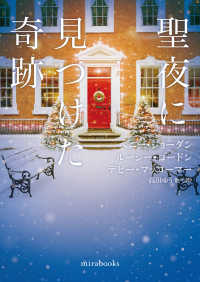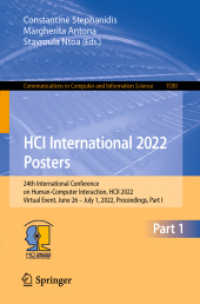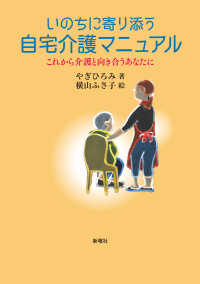Full Description
This volume deals with the female dynasty of the House of David and its influence on the Jewish Messianic Myth. It provides a missing link in the chain of research on the topic of messianism and contributes to the understanding of the connection between female transgression and redemption, from the Bible through Rabbinic literature until the Zohar. The discussion of the centrality of the mother image in Judeo-Christian culture and the parallels between the appearance of Mary in the Gospels and the Davidic Mothers in the Hebrew Bible, stresses mutual representations of ""the mother of the messiah"" in Christian and Jewish imaginaire. Through the prism of gender studies and by stressing questions of femininity, motherhood and sexuality, the subject appears in a new light. This research highlights the importance of intertwining Jewish literary study with comparative religion and gender theories, enabling the process of filling in the 'mythic gaps' in classical Jewish sources. The book won the Pines, Lakritz and Warburg awards.
Contents
AcknowledgementsIntroduction
Part One: Messianic Mothers in the Bible
Ruth, Tamar, and Lot's Daughters
Chapter One: Feminine Genealogy and the Lineage of the House of David
Two Genealogical Lists at the Conclusion of the Book of Ruth
The Feminine Genealogical List—Exclusion or Redundancy?
The Blessing at the Gate
Like Rachel and Like Leah
The Mothers of the Davidic Dynasty in Chronicles
The Foreign Women of the House of David
Dynasticism, Eros, and Messianism
Feminine Dominance and Antinomianism in the "J" Source
Chapter Two: The Type-Scene of "The Birth of the Messianic Hero"
1. The Background: The Appearance of the Foreign Woman
2. The Crisis—Human and Cosmic Traumatizing Circumstances
3. The Obstacle—The Sexual Prohibition: Incest, Harlotry, and Seduction
4. The Messianic Fathers—The Symbolism of the Father Figure
5. The Secret and Seductive Means—Wine, Masquerading, and Concealment
6. The Danger—The Men's Unawareness and the Woman's Endangerment Post-Seduction
7. The Birth—From Virginity to Motherhood
8. The Human Condemnation—Breaking of Ties and the Disappearance of Mother and Father Figures
9. The Divine Vindication—The "Providential Type-Scene" and Genealogical Seal
The Motif of Doubleness in the Stories of the Davidic Mothers
Sexuality and Messianism
The Development and Tempering of the Type-Scene—What Do the Foremothers Bequeath to Their Daughters?
Part Two: The Messianic Mother in Rabbinic Literature—Sororal Love and "Ethics of Redemption"
Chapter Three: David's Mother(s) in Yalkut ha-Makhiri
Son of the Hated and Son of the Loved—The Holy Deception
The Absent Mother and the Excessive Mother
Connected Midrashim between Davidic Mothers
Chapter Four: Gedolah Aveirah Lishmah—From Rabbinic Literature to the Messianic Teachings of R. Moses Ḥayyim Luzzatto
The Background of the Sugiyah—Ḥeruta's Story and "The Revolution of Intention"
Aveirah Lishmah and Devar Mitzvah
Aveirah Lishmah according to R. Moses Ḥayyim Luzzatto
Women as the Other: Gender, Language, and Politics
Part Three: The Messianic Mother in the Zoharic Literature
The Mystery of the Composition of the Zohar and its Character
The Messianic Idea in the Zoharic Literature
Chapter Five: Lot's Daughters and the Zoharic "Ṭiqla"
The Paradoxicality of Incestuous Relations in Cultural and Psychoanalytic Studies
Incestual Relations in a Gender Perspective
The Primal Story and "Primal Scene"
Ammon and Moab—Split Attitudes
The First Appearance of the Ṭiqla: Spain of the Thirteenth Century
Zohar Parashat Va-Yera—the Story of Lot's Daughters
The Origins of the Ṭiqla in the Greek Water-Wheel of "Antiliya"
Ṭiqla in the Zohar—Five Axes of Meaning
Conclusion
Chapter Six: The Burning Face of the Shekhinah—Tamar in Zohar Aḥrei Mot
The Passage's Framework—An Opening to Supernal Mysteries
The Burning Image—The Smoldering Shekhinah
Petaḥ Einayim—From Rabbinic Midrash to Zoharic Exegesis
Tamar's story and the Motif of Fire in Zohar Aḥrei Mot—A Mirror to the World of the Kabbalists
Chapter Seven: "And She Uncovered His Feet"—The Exilic and Redemptive Journey of the Shekhinah
The Book of Ruth and the Threshing Floor Scene—From the Bible to Second Temple Literature
Ruth in the Zohar—"And She Uncovered His Feet"
The Personal Stance—Ruth as the Messiah's Mother and an Actual and Active Character in the Zohar
Ruth and Tamar—The Shared Model
The Allegorical Position—Zohar Ruth and Tiqqunei Zohar
The Distant Redeemer, The Close Redeemer—Tiqqunei Zohar in Contrast to Zohar Ruth
Naomi and Ruth as Binah and Malkhut
An Existentialist Reading—The Shekhinah is the Soul
The Zohar in Contrast to the Tiqqunim and Zohar Ruth—The Personalistic Model and the Allegorical Model
Conclusion—Gender Reversal and Redemption Poetics
Epilogue: The Messianic Mother in Judaism and Christianity
The Mother of the Messiah in the Bible and in Early Christianity
A Messiah by Virtue of His Mothers
Christian Traditions and Jewish Rabbinic Literature
A) Miraculous Conception: "A Seed That Comes from Another Place"
B) Sexuality and Virginity: "All Those Women of the House of Rabbi Who Crushed with Their Finger"
D) Seduction, Trauma and Relationships
E) Late Subversion in a Medieval Midrash
F) The Messianic Mother as a Virgin and Harlot—Influences on the Perception of the Shekhinah in the Zohar
Bibliography







